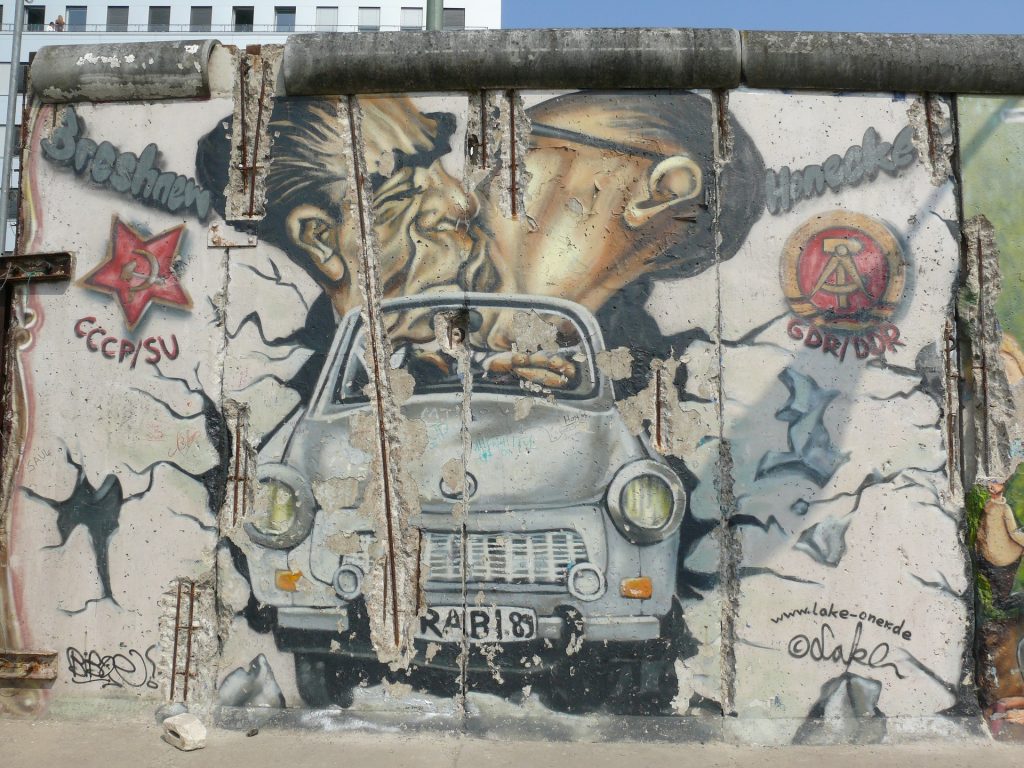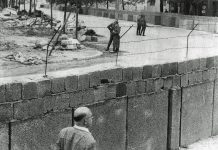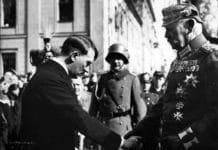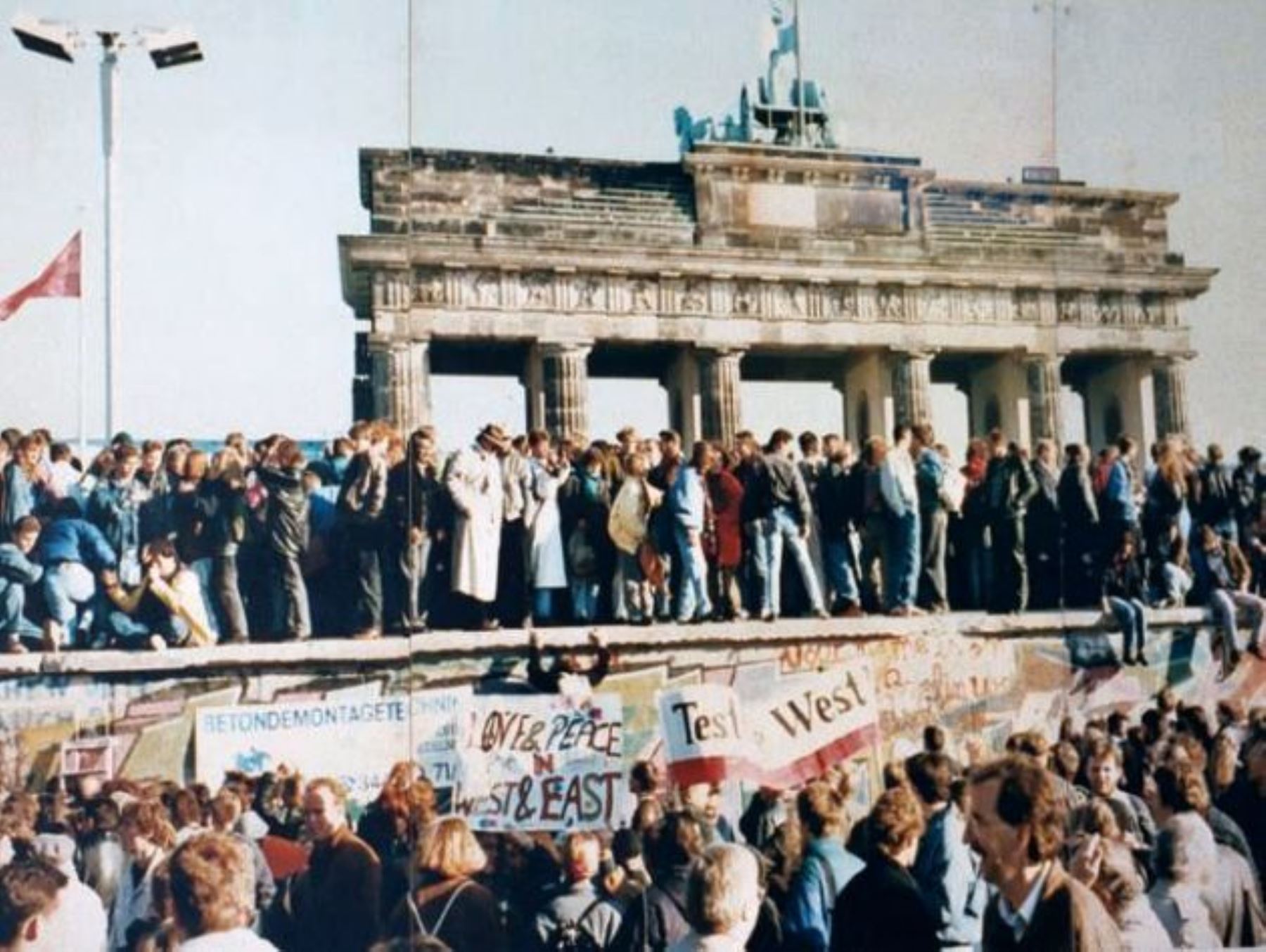
Linkbox om Berlinmurens historie, dens fald i november 1989 og stalinismens sammenbrud i Østeuropa. Om aftenen 9. november 1989 faldt muren i Berlin, da befolkningen fik lov til udrejse. Selve Berlinmuren blev først fjernet senere. Her er samlet links om Berlinmurens historie og især – på engelsk – om den politiske og historiske betydning af murens fald.
Bjarne A. Frandsen, november 2009.
Revideret november 2019.
Indhold
- Leksikon-artikler
- Litteratur
- Artikler/Articles
- Om stalinismens sammenbrud
- Se også
- Se også på Socialistisk Bibliotek
Leksikon-artikler
- Berlinmuren (Leksikon.org)
- Murens fald + Berlinmuren (Denstoredanske.dk)
- Berlinmuren (Wikipedia.dk)
- Berlin Wall (Wikipedia.org)
- Monday demonstrations in East Germany (Wikipedia.org)
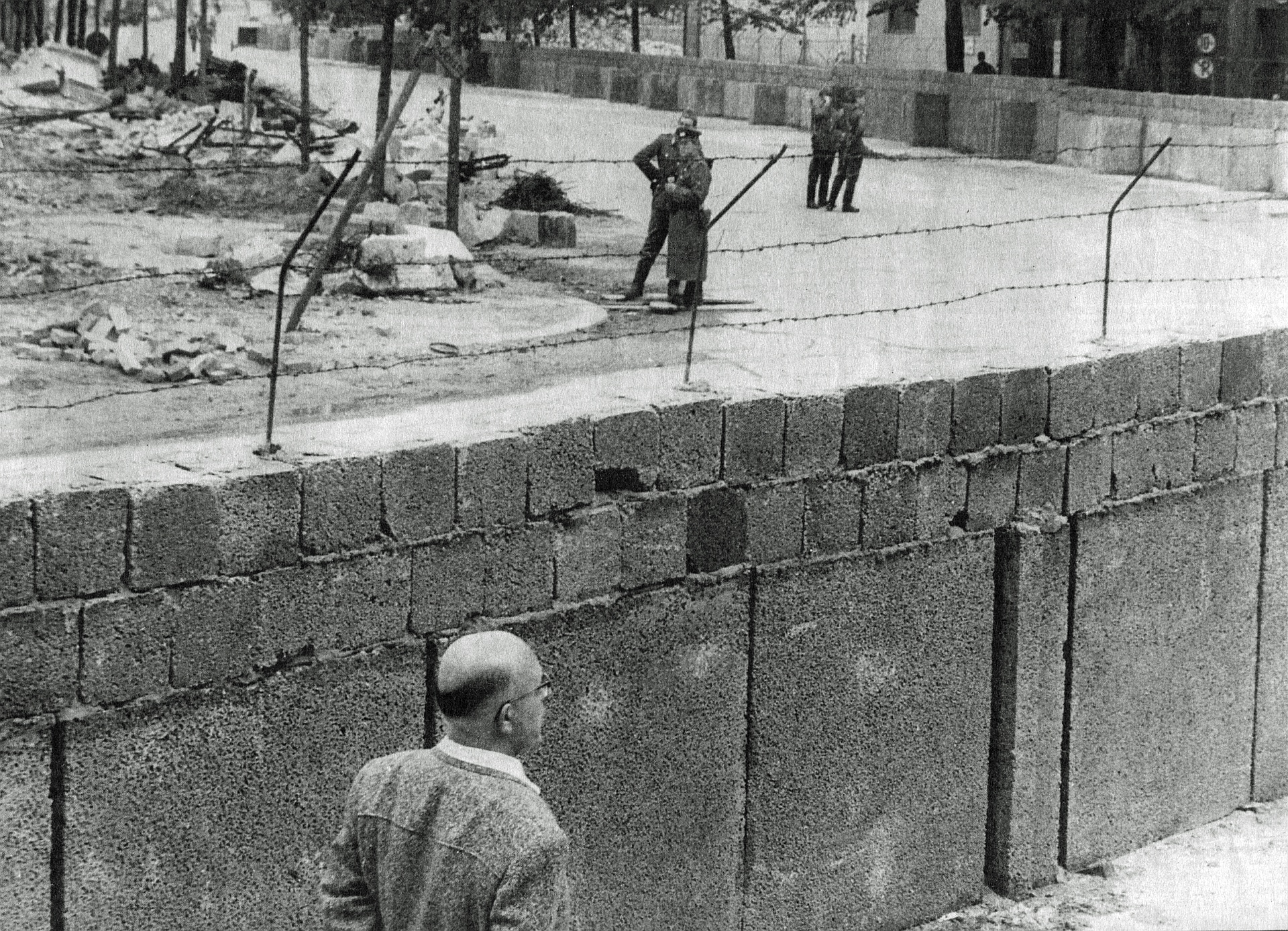
Se også:
- Timeline: 1989 (Socialism Today, Issue 133, November 2009)
- Timeline: how the wall was stopped (International Socialism, Issue 124, Autumn 2009)
- 1989: Timeline of revolution (Socialist Worker, Issue 2176, 7 November 2009)
- A division through time (The New York Times, November 9, 2009). Med fotogalleri om Berlinmuren før og nu.
Litteratur
Muren: historien om et politisk bygningsværk. Af Jan Bo Hansen (Gyldendal, 2009, 326 sider). Anmeldelse på af Simon Ankjærgaard på Historie-online.dk.
Artikler
Frigjøring og annektering. Af Pierre Rimbert og Rachel Knaebel (Le Monde Diplomatique, november 2019/Kritisk Debat, december 2019). “For østtyskerne er Berlinmurens fall en fortelling om politisk frihet og frigjøring fra et forhatt regime, men også en fortelling om et land og et folk som ble avviklet og økonomisk ruinert.”
Berlinmurens historie er stadig relevant i dag 30 år efter dens fald. Af Andrew Bonnell (Videnskab.dk, 9. november 2019)
“Berlinmurens fald markerede starten på en ny verdenhistorisk epoke. Muren kaster stadig sine lange skygger ind i nutiden.”
Berlinmurens fald. Af Alan Woods (Revolution, 9. november 2014)
“Denne artikel blev skrevet i 2009 i anledning af 20året for murens fald: For tyve år siden, da Berlinmuren styrtede sammen, var borgerskabet i Vesten euforisk, og jublede over ‘kommunismens fald’. Tyve år senere, hvor kapitalismen er gået ind i den mest alvorlige krise siden 1929, ser tingene meget anderledes ud.”
Hvem var den basisdemokratiske opposition i DDR? + De vilde år omkring DDRs sammenbrud (Autonom Infoservice, 28. august + 12. september 2014)
“Interview med en autonom aktivist der som ganske ung oplevede en progressiv opposition mod det østtyske bureaukratregime og som deltog i den autonome bz- bevægelse i Østberlin før og efter murens fald.”
Berlinmuren skabte balance i Europa (Information.dk, 12. august 2011)
“Vesten havde om ikke ønsket Muren, så dog affundet sig med den som en mulig løsning på den konstante konflikt om Berlin, skriver Per Øhrgaard i en personlig beretning i anledning af 50-års-dagen for opførelsen af ‘den antifascistiske beskyttelsesvold’.”
In English:
The lost history of East Germany. By Samuel Clowes Huneke (The New Republic, September 22, 2023)
Review of Katja Hoyer, Beyond the Wall: East Germany 1949-1990 (Penguin, 2023, 496 p.): “Katja Hoyer argues for a closer look at the triumphs and travails of everyday life under socialism.”
When the wall came tumbling down (Socialist Worker, Issue 2679, 5 November 2019) “Tomáš Tengely-Evans revisits 1989 when the Berlin Wall was felled by mass protests and argues that so-called socialist regimes in eastern Europe were nothing of the kind.”
June 17, 1953. By Gareth Dale (Jacobin: Reason in Revolt, 17 June 2016)
“On this day in 1953, a strike in Berlin turned into a nationwide rebellion for workers’ power in East Germany.”
How the Wall fell. By Bernd Gehrke (Jacobin: Reason in Revolt, December 27, 2015)
“The Berlin Wall’s fall sparked dreams of a radically democratic East Germany. Unemployment and privatization followed instead.”
What reunification wrought. By Gareth Dale (Jacobin: Reason in Revolt, October 3, 2015)
“East and West Germany reunified 25 years ago today. But for most workers, the hopes of that day were dashed.”
Berlin: the wall that came down and the walls that went up (Counterfire, November 8, 2014)
“John Rees was reporting from Berlin 25 years ago as the demonstrations which brought down the Stalinist dictatorship reached their peak. Here he reflects on the consequences of the fall of the Berlin Wall.”
East Germany, 1989: When power was in the street. By Olaf Klenke (RS21: Revolutionary Socialism in the 21st Century, November 7, 2014)
“Within a few weeks in the autumn of 1989 a regime fell which had seemed invulnerable for decades. While Reagan and Thatcher seek to take credit for these momentous events, the truth is that millions of East German people took their destiny into their own hands.”
Twenty five years since the fall of the Berlin Wall: A balance sheet. By Peter Schwarz (World Socialist Web Site, 8 November 2014)
“The attempt to recast the end of the GDR as a liberal revolution and summon up the euphoric atmosphere that marked the fall of the Berlin Wall has one goal: to prevent the drawing of a sober balance sheet on German reunification and consideration of what really happened in the autumn of 1989.”
Eyewitness to revolution. By Dennis Kosuth (International Socialist Review, Issue 71, May–June 2010). Review of Michael Meyer, The Year that Changed the World: The Untold Story Behind the Fall of the Berlin Wall (Scribner, 2009)
“Meyer does paint a vivid picture of what took place day by day on the ground and in the offices of the leadership.”
The revolutions of 1989: bringing down the Wall (Socialist Worker, Issue 2176, 7 November 2009). Med links til fem kortere artikler.
“Gabi Engelhardt was a leading member of the underground left in East Germany when the Berlin Wall came down in November 1989. She spoke to Yuri Prasad about her experiences, and the unfinished business of the revolution that she and her comrades helped to initiate.”
Theme: 1989: The fall of the Wall (Socialism Today, Issue 133, November 2009)
Med links til fem artikler om DDR, Polen og USSR.
The fall of the Berlin Wall: 20 years later. By Alan Woods (In Defence of Marxism, 9 November 2009)
“Twenty years ago as the Berlin Wall came tumbling down the bourgeoisie in the west was euphoric, rejoicing at the ‘fall of communism’. Twenty years later things look very different as capitalism has entered its most severe crisis since 1929. Now a majority in former East Germany votes for the left and harks back to what was positive about the planned economy.”
A short autumn of utopia: The East German revolution of 1989. By Gareth Dale (International Socialism, Issue 124, Autumn 2009, p.39-69)
“November marks the 20th anniversary of the fall of the Berlin Wall, Which symbolised the collapse of the Eastern European regimes that many people viewed as socialist. Gareth Dale , who was in East Germany at the time, presents a different picture: that of a popular uprising against a variant of state capitalism.”
Stronger than the wall. By Mike Haynes (International Socialism, Issue 114, Spring 2007, p.191-194)
“Three books in as many years are an achievement by anybody’s standards. What Gareth Dale has done here is more – through his discussion of the rise and fall of East Germany (the GDR) he has staked out a claim as a major influence on our interpretation of events in the second half of the 20th century in Europe.”
Class struggles in the 1989 revolution (RS21: Revolutionary Socialism in the 21st Century, 8 November 2019)
“Here we publish a translation of an article by Volkhard Mosler, originally published in 1994, which analyses the class composition of the East German regime and the opposition movement to it. He dismantles the notion that the East German regime had anything to do with what we would mean by ‘socialism from below’, and simultaneously challenges some of the myths about the role played by the self-styled leaders of the opposition.”
Making revolution: The rebirth of East German socialism. By Ernest Mandel (The Village Voice, November 21, 1989; online at Marxists Interner Archive)
“A combination of May ’68 in France and the Prague Spring, multiplied by two: That’s how you can summarize what is occurring at present in the German democratic revolution. It’s the beginning of a genuine revolution, a struggle to build a democratic, popular alternative to both communist oppression and free-market despotism.”
Om stalinismens sammenbrud
Revolutions of 1989 (Wikipedia.org)
1989 som historisk chance?: arbejderbevægelsen i den tyske omstillingsproces på baggrund af den historiske udvikling fra 1945 til 1990 (pdf). Af Karl Christian Lammers (Årbog for arbejderbevægelsens historie, nr. 21, 1991, side 189-199).
Åter till 1989 års revolutioner (pdf). Av Catherine Samary (Tidsignal, nr.11, 2010, 25 s.; online på Marxistarkiv.se). “Tillbakablick till året då Berlinmuren föll och ‘realsocialismen’ började bryta ihop i Östeuropa, en utveckling som kulminerade med Sovjetunionens upplösning 1991.”
Stalinism’s long shadow. By Tomáš Tengely-Evans (International Socialism, Issue 173, Winter 2022)
“Some 30 years ago, the red flag was lowered over the Kremlin for the last time as the Soviet Union collapsed on 25 December 1991. Yet, although that Stalinist regime is dead, Stalinism continues to cast a long shadow on the left.”
Central and Eastern Europe 30 years on. By John Cunningham (Solidarity & Workers’ Liberty, Issue 529, 18 December 2019)
“… the crucial issue facing the people of Central and Eastern Europe: their failure to develop a democratic-socialist alternative to the economic and political neoliberalism that was foisted on them by the USA and the EU post-1989, and many enthusiastically embraced.”
Reflections on the meaning of Stalinism (pdf). By Paul Le Blanc (Crisis and Critique, Vol.3, No.2, March 2016, p.81-106)
“In what follows, I will begin by indicating my own personal/political connection to Stalinism, traveling from that to reflections on its origins, then an analysis of its development and of how it can be defined.”
Stalinism and historical responsibility. By James Heartfield (The Project: A Socialist Journal, May 2015)
“With the collapse of the eastern bloc over the years from 1985-1993 Stalinism ceased to be a factor in world politics … looking back at the period between 1923 and 1993, how we understand the question of leadership in the working class movement is an important historical question. This essay is an attempt to look at the balance sheet.”
Revolutions of 1989: how the old regime was torn down (Socialist Worker, Issue 2428, 4 November 2014)
“Revolt swept across Eastern Europe 25 years ago, toppling the Berlin Wall and the Stalinists who built it. The real socialists were cheering, argues Tomás Tengely-Evans.”
Revolutions of 1989: ‘there was lots of shock and not much therapy’ (Socialist Worker, Issue 2428, 4 November 2014)
“Socialist Worker spoke to Jane Hardy, a socialist activist and writer specialising in global political economy. Her book, Poland’s New Capitalism (2009) was translated into Polish and has been read by the new left there.”
1989: the fall of Stalinism. Part 103 in Neil Faulkner: A Marxist History of the World (Counterfire, 2 December 2012)
“The revolutions of 1989 represent great victories for mass action, but they were limited in effect.”
Confronting the Stalinist legacy. By Corey Oakley (Marxist Left Review, No.2, Autumn 2011)
“Stalinism infected almost every aspect of left wing politics, well beyond the official bearers of “socialist truth” in what were once monolithic communist parties. Stalinism transformed the way the left viewed revolution, leadership, states and classes, and their role in social struggle. It grotesquely distorted Marxism …”
The revolutions of 1989. By Alan Maass (SocialistWorker.org, November 12, 2009)
“The fall of the Berlin Wall 20 years ago was one crest in a wave of revolt that overturned governments across half of Europe at the end of 1989.”
1989-2009: celebrations muted by the disappointments of the present. By Mike Haynes (Socialist Review, Issue 341, November 2009; online at Internet Archive)
“What happened to the illusions that free market capitalism would bring democracy, social justice and equality to the societies of Eastern Europe?”
Stalinism and after. By Peter Taaffe (Socialism Today, Issue 133, November 2009)
“The collapse of Stalinism was used in a global ideological offensive against socialism, which was unjustly equated with that dictatorial, bureaucratic system, to drive through brutal, neo-liberal capitalist policies worldwide.”
Revolts behind the ‘iron curtain’ (SocialistWorker.org, November 6, 2009)
“Dennis Kosuth recounts the history of resistance that plagued the rulers of the Eastern bloc from the moment they established the regimes they falsely claimed were socialist.”
Socialism, Stalinism and Eastern Europe (SocialistWorker.org, November 3, 2009)
“Phil Gasper contrasts the so-called socialist regimes of Eastern Europe 20 years ago with the principles at the heart of the socialism movement historically.”
The fall of Stalinism in Eastern Europe (Workers’ Liberty, 3/25, 2009)
“The articles in this pamphlet issue document the attempts to understand those epoch-defining events, including the role and attitudes of the working class in the Stalinist states.”
1989 and why we got it wrong (pdf). By Michael Cox (London School of Economics and Political Science/Working paper, 1/2000, 14 p.)
“This essay seeks to explain why ‘we’ got it wrong by focusing in the main on how ‘we’ in the West understood the Soviet system … In conclusion I offer reflections on how the generally flawed understanding of the Soviet Union precluded the anticipation of Soviet collapse.”
The anti-Stalinist revolutions in Eastern Europe, 1989-90 (Workers Liberty, 26 April 2007)
“A collection of articles on solidarity with workers in Eastern Europe before the revolutions of 1989, and on those revolutions and the prospects they opened up.”
Theories of revolution in the light of 1989 in Eastern Europe: Marxism and the 1989 Revolution (pdf). By Colin Barker and Colin Mooers (Cultural Dynamics, Vol. 9, No.1, 1997, p.17-43)
“This paper explores several issues in the light of the events of 1989. What does ‘revolution’ mean? What did and did not happen in 1989? What categories make sense of these events, and in what theoretical light should we read them?”
The fall of Stalinism: ten years on. By Anthony Arnove (International Socialist Review, Issue 10, Winter 2000, p.43-52)
“By the end of 1991, Stalinist regimes that had seemed unshakable for decades were overthrown … This was a tremendous victory for genuine socialism. But almost universally the opposite conclusion was drawn. Whether on the left or on the right, commentators treated 1989 and then 1991 as the ‘triumph of capitalism’ and the ‘death of Marxism’.”
The Soviet Union and Eastern Europe: The roots of the crisis. By Robert Brenner (Against the Current, Issue 30, January-February 1991) + Part 2: Nature of transition (Issue 31, March-April 1991)
“In the first part of the article Brenner describes the nature of the Eastern bloc’s economic system, the failure of the market reforms of the 1970s, the exacerbation of the Eastern bloc’s productivity crisis via the arms race with the United States … The second part provides a prescient analysis of the likely outcome of the political and economic crisis in Eastern Europe and the Soviet Union.”
The storm breaks: The crisis in the eastern bloc. By Chris Harman (International Socialism, Issue 46, Spring 1990, p.3-93)
“Those left wingers who believed that Russia and the Eastern European regimes were socialist societies are now demoralised … Chris Harman argues against this pessimism, and shows that what we are seeing is not the destruction af socialism but the crisis of state capitalism.”
The struggle goes on. By Chris Harman (Socialist Worker Review, No.126, December 1989)
“Old governments have fallen like dominoes in Eastern Europe. From Warsaw to Prague, members of the old regimes have been forced to reassess their positions.”
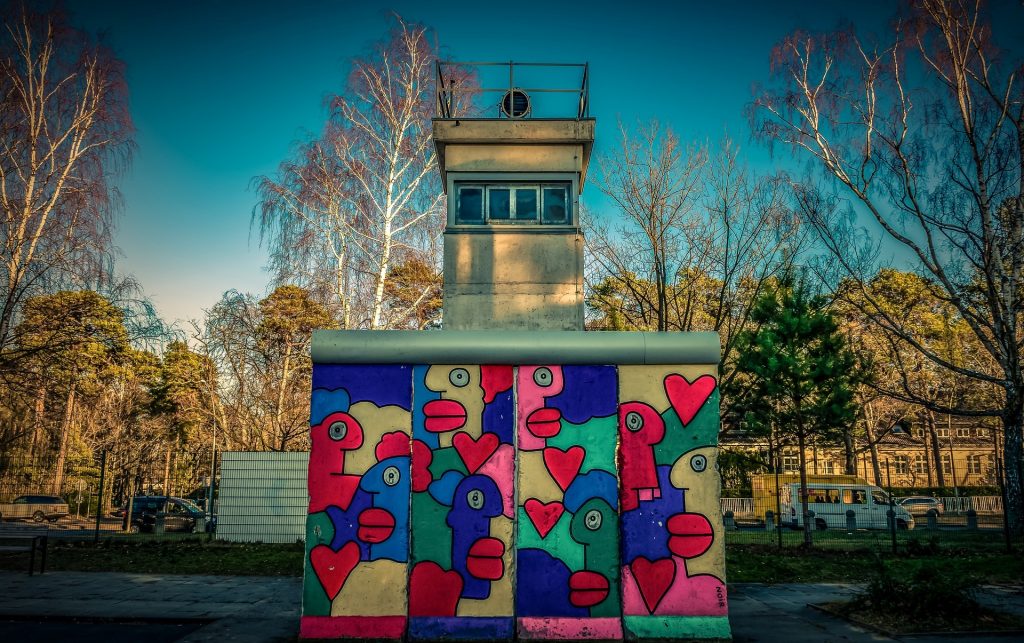
Se også:
Bureaucratic collectivism + Degenerated workers’ state + State capitalism (Wikipedia.org)
Sovjets karaktär (Marxistarkiv.se)
“Texter som diskuterar Sovjetunionens karaktär (‘statskapitalism’, ‘degenererad arbetarstat’, etc).”
Critiques of Stalinism (Marxists Internet Archive; Stalinism Subject Archive)
Trotskyists (Leon Trotsky, Tony Cliff, Ernest Mandel) – Left Communists (Paul Mattick, Otto Rühle) – Marxist Humanists (Raya Dunayevskaya, C.L.R. James) – Additional Critiques.
Diskurs. Hvad var Sovjetunionen for et samfund? Hvad gik der galt og hvorfor? Del 1 +
Del 2 (Autonom Infoservice, 9. august + 28. august 2017)
“Hvad var Sovjetunionen for en samfundsmæssig størrelse: kapitalistisk?, statskapitalistisk?, degenereret arbejderstat?, bureaukratisk kollektivistisk?, statssocialistisk? eller …?”
The place of the Soviet Union in history. By Jack Conrad (Weekly Worker, Issue 1216, 17 August 2018)
“The USSR was neither a new type of capitalism, nor a ‘degenerate’ socialism, but a freakish new social system.”
Actually existing ‘socialism’: a critique of Stalinism. By Charlie Post (New Socialist, February 16, 2018)
“Today, an identification with the bureaucratic regimes masquerading as socialism undermines the rebuilding of an anti-capitalist left.”
Stalinism and historical responsibility. By James Heartfield (The Project: A Socialist Journal, May 2015; online at Internet Archive)
“… looking back at the period between 1923 and 1993, how we understand the question of leadership in the working class movement is an important historical question. This essay is an attempt to look at the balance sheet.”
Western Marxism and the Soviet Union: A Survey of Critical Theories and Debates Since 1917 (pdf). By Marcel van der Linden (Brill, 2007, 380 p.; online at Libcom.org)
“The ‘Russian Question’ was an absolutely central problem for Marxism in the twentieth century.” Se uddrag på svensk: Västerländsk marxism och Sovjetunionen (pdf)(Marxistarkiv.se, 25. marts 2020, 61 s.).
Reviews:
Returning to the Russian question. By Chris Harman (International Socialism, Issue 118, Spring 2008).
Kritiska teorier om Sovjetunionen (pdf). Av Paul Flewers (Marxistarkiv.se). Översatt från
tidskriften Revolutionary History (Vol.10, No.1, 2009).
Theories of Stalinism. By Paul Le Blanc (Against the Current, Issue 143, November-December 2009). Svensk udgave: Teorier om stalinismen (pdf) (Marxistarkiv.se, 25. februar 2019, 10 s.).
The puzzle of the 20th century. By Martin Thomas (Solidarity, Issue 419, 12 October 2016) + longer review: The mistakes of Mandel and Cliff on the Russian question (Workers’ Liberty, 26 September 2009).
Debate Chris Harman and Ernest Mandel (International Socialism, 1969-1990):
Chris Harman: The inconsistencies of Ernest Mandel (Issue 41, December 1969/January 1970, p.36-41). Review of Ernest Mandel’s pamphlet The inconsistencies of state capitalism.
Chris Harman: From Trotsky to state capitalism (Issue 47, Sommer 1990, p.137-156). Review of Ernest Mandel’s book Beyond Perestroika.
Ernest Mandel: A theory which has not withstood the test of facts (Issue 49, Winter 1990, p.43-64). Reply.
Chris Harman: Criticism which does not withstand the test of logic (Issue 49, Winter 1990, p.65-88). Reply.
Russia: A Marxist Analysis (1964). By Tony Cliff (Marxists Internet Archive). “This text is an extended version of Stalinist Russia: A Marxist Analysis, which was originally published in 1955.”
Se også på Socialistisk Bibliotek:
- Tidslinjen 19. august 1991 om Sovjetunionens opløsning.
- Emnelisten Den Russiske Revolution 100 år
- Emnelisten Den Russiske Revolution, fra februar – oktober 1917
